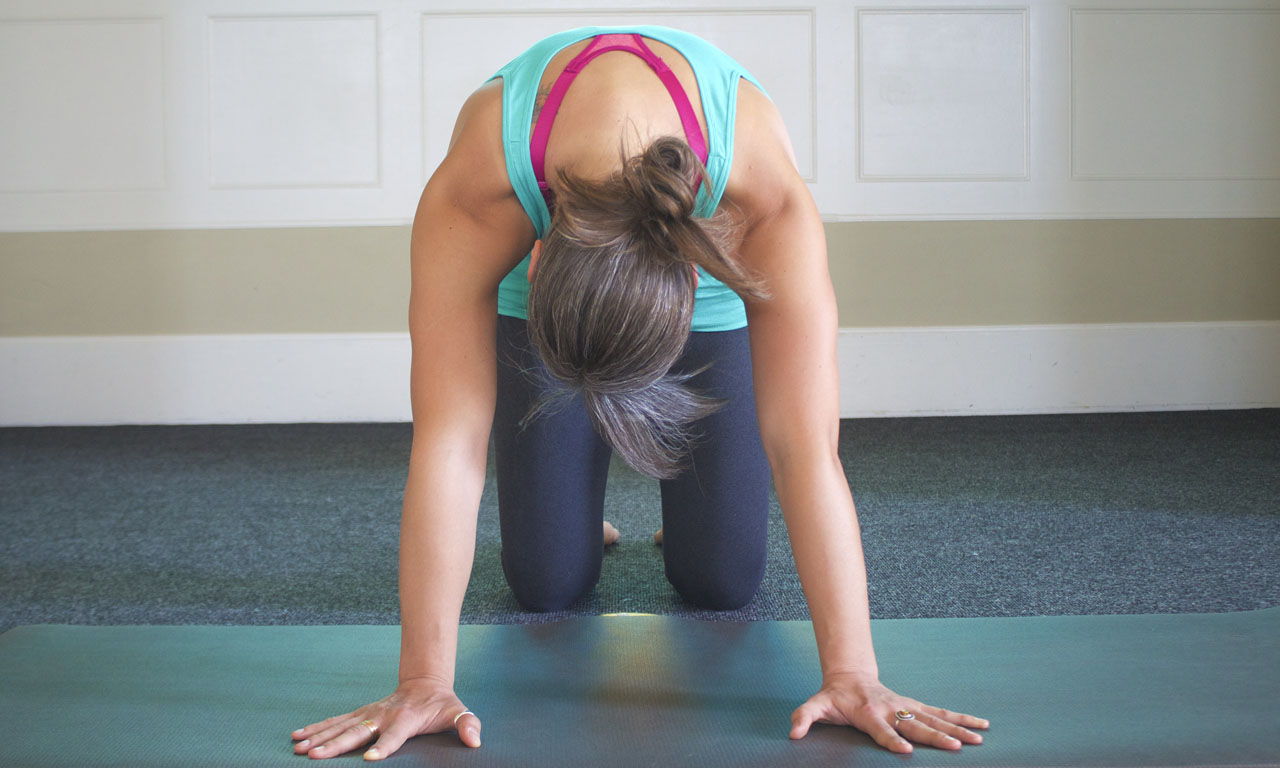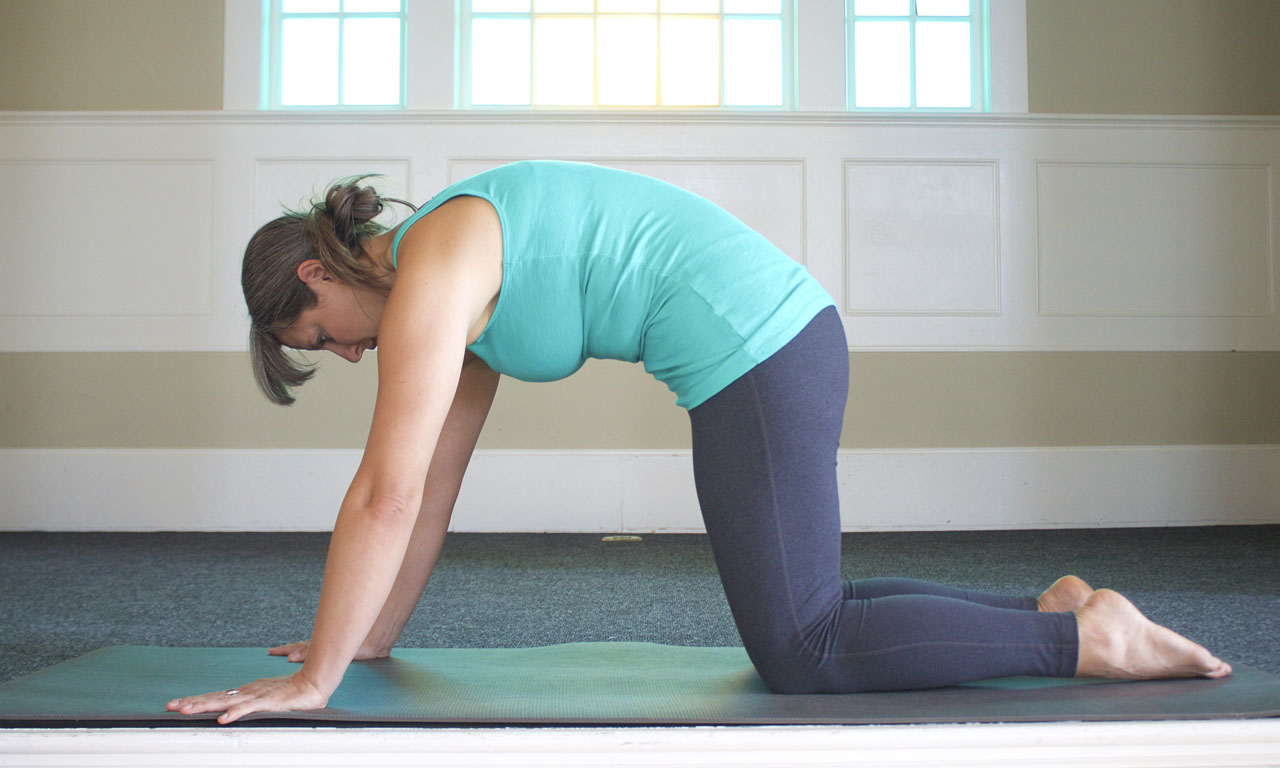Cat/Cow
Cat/Cow has just as much potential to form core strength and build mind-body awareness as any other pose you perform.
Sometimes, when we’ve been practicing yoga for a long time, and we feel like our practice has advanced beyond a certain point, we can look at a pose like Cat/Cow and think, “I’m a grad student doing the work of a preschooler — why would the teacher bring THIS to class.” If this is your thought process, then frankly, you’re doing it wrong.
EVERY pose has the potential to challenge EVERY practitioner, because if there’s only one thing I’ve ever learned about yoga practice, it’s that you get out what you put in. Cat/Cow is a practice that can seem so elementary that we don’t even try, and that is where the error occurs. Cat/Cow has just as much potential to form core strength, extremity/core connections, and build mind-body awareness as any other pose you perform, IF you put in the effort. As an advancing practitioner, you should have the finer awareness to access smaller muscles and work with more finesse. By accessing and integrating the whole of the body, your Cat/Cow can become a very powerful posture flow.
I observe students practicing Cat/Cow with too much emphasis on the movements at the hips and shoulders, often times swaying significantly forward and back as they breathe. This style wastes a ton of energy. While the work at the shoulders, arms and legs is integral to performing this flow, our action should be initiated from our center and move out through the limbs. This means our Solar Plexus should be where our effort begins, sending energy undulating out in both directions through the ends of the spine, and the limbs playing a supporting role in our relationship to the Earth and gravity. Every joint in the spine should receive the same amount of movement energy, not just the most flexible points. To achieve this we’ll need to be active in both the front and back channels, find fluidity in our strong muscular contractions, but be aware enough to not succumb to clenching or swaying.
In Cat, the upper body does MOST of the work. The tail drops heavy along with the head. The Solar Plexus pulls in deeply and the hands/ankles press down to engage the limbs.
In Cow, the effort is accentuated in the upper body, arms pulling back so the sternum can pull forward. The belly supports the front body so the mid- and low-back don’t simply collapse in gravity.
Note that elbows pointing out to the sides lack stability, as well as pull the knuckles away from the Earth, eliminating Hasta Bandha.
I’d also like to note here that even though we typically call this posture Cat/Cow, we often begin practice with an inhale to a Cow Pose. I think there is a ton of value in beginning with Cat and a set of powerful cleansing exhales, toning the belly and activating the shoulder girdle. We can really tune into our connection with the ground, unwind tension at the base of the skull and the tail, and start to build heat immediately.
Let’s practice:
Note the hyperextension in the wrists. You need to shift your whole body back until the plane of the arm is behind the crease of the wrist to avoid this.
CAT — Begin in Table Pose.
Make sure hands are wide enough to accommodate the full width of your shoulders. If our hands are too narrow on the mat two things happen — we over engage our chest muscles, throwing us off balance, and we risk impingement of soft tissue structures in the shoulder joint. Both of these conditions lead to injury over time. Some people also have a lateral deviation in the elbow joint that results in the forearms point out to the sides when the upper arm bones are parallel. We call it a Carrying Angle. These folks will need to take their hands wider than their elbows for all postures where the hands are on the ground. See details in the Glossary. Also, make sure the front plane of your shoulder is just behind the crease in the wrist to avoid hyperextension. This will allow for Hasta Bandha to engage and potentially take pressure out of the wrist joints.
Push the Earth away using knuckles, fingertips, and ankles.
Newton’s third Law of Physics says that for every action there is an equal and opposite reaction. Philosophically at least, this means that the more we push the Earth away from us, the more the Earth pushes us away too. So, if you push your extremities down into the mat, The mat will push back and you will achieve lift. You can use this principle for any posture which is weight bearing in the limbs.
Gather belly deep toward spine.
Your intention should not be only to lift the spine toward the sky, but also to pull the organs in and up from all sides, pressurizing the fluid body in support of the spinal joints. This hydraulic pressure becomes far more powerful in stabilizing the spine than skeletal muscles are on their own. This action also ensures the release of the most volume of air in exhalation, clearing lung space for more clean air on the following inhalation.
Wrap the shoulder blades from the back body around to the side ribs and armpits.
This action effectively engages the chest and shoulder girdle muscles, but also aligns the head of the humerus with the scapula for optimal efficiency and safety. It is these muscles that do the majority of the work in this pose…
Head dangles heavy.
It’s important that the back neck remains relaxed here. Check in with your jaw and face. The first few rounds, it may be helpful to look slowly left and right to ensure release at the base of the neck and skull. This teaches your brain over time that the shoulder girdle, chest and upper back can be working hard while the face, neck and throat remain soft and relaxed.
This version of Cat is using too much gluteus action. The upper core tends to lack engagement in this scenario and the head has a tough time releasing completely.
Hips remain soft as the tail moves naturally as an extension of the spine — not as a clenching or tucking contraction.
Let’s say that 60% of the effort of Cat should come from the shoulder girdle and arms, 35% should come from the lifting of the belly and the remaining 5% should come from the legs pressing into the Earth. Hard hips are heavy hips, so practicing in this way will condition you for lift-off in future inversion postures.
Practice.
It could be good practice to do a few rounds of just Cat pose, neutralizing with each inhale just to get a solid sense of cleansing and toning before activating the back bending shape of Cow.
COW — Start from Cat or Table Pose.
See above cueing.
Elbows bend and wrap toward ribs, pointing back toward your thighs.
These actions equal external rotation at the shoulder and align the shoulder joint for a back bend.
Note that hands are wide enough that thumbs align just outside the crease of the armpit, and that the hands are turned out to accommodate the bending of elbows straight back.
With hands rooted in the mat, pull upper arm bones back in space.
Cow is a back bend. Ideally, the entire spine should activate to avoid pinching or hinging at the most mobile points. Pulling the arm bones back activates the broad Lattisimus Dorsi from ribs to tail, supportive of the lumbar curve. This action can also help engage Serratus Anterior, a deep shoulder girdle muscle that will help broaden the upper back.
Shoulder blades gather behind the heart.
You’re reversing the curve of your spine from Cat pose, so you’ll engage the opposing muscle groups. It is here that the majority of the muscular effort arises for Cow. The Trapezius and Rhomboids adduct the scapulae to broaden the chest so it can lengthen forward. This action can be overdone, however, so it must be countered a bit, or you risk a big log-jam in the upper thoracic spine and diminished capacity for extension. See the next cue for details.
Using Serratus you’ll pull the bottom tips of the shoulder blades around the ribs toward armpits.
This is a subtle action, and frankly, many of us don’t have the acuity to activate this muscle just so. It takes time and a ton of practice to learn how to contract Serratus in this fine way — so until it clicks, pretend you can do it. Consider doing whatever action makes sense in your own mind to counter the pulling back of the shoulder blades as described in the preceding cue. Play with it. Any counteraction here will add support to the heart and help it stay broad and long while adding power and lift to the pose.
Reach the sternum open and long toward the front of the room.
It’s really tempting here to shift the whole body forward to feel longer, but please resist the urge. Try to stay firmly planted in between your knees and hands, and energetically lengthen through the sternum.
Belly supports the soft bend in low back, and hips/tail are rather soft, lengthening backward.
There is a hinge in the front of the hips as the back bend takes shape, but this is not an active pulling or deepening. You don’t want to dump into the low back, you want the effort of the pose to be centered at the heart, letting the tail come along for the ride. There may be a sense of the tail actually lengthening to the back of the room in order to create more space for the upper-back bend to take shape. The ankles remain heavy.
Pull vocal cords gently back into the neck spine to avoid breaking in the back neck.
Avoid looking straight ahead or you risk collapsing the back neck. Use the gentle lifting of the throat to emphasize length along the back neck, so the spine makes a gradual curve from tail to crown, without any sharp bends along the way.
Flow.
Of course, the beauty of Cat/Cow is engaging in the flow between the two…so once you are familiar with the subtle yet potent actions of each, move from one to the other in time with your breath cycle. Let the breath flow long and full, don’t rush.







